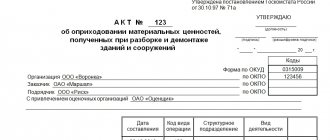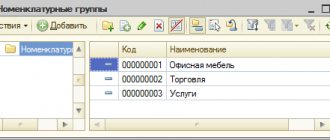Kontur.Accounting is a web service for small businesses!
Quick establishment of primary accounts, automatic tax calculation, online reporting, electronic document management, free updates and technical support.
Try it
To organize efficient production, it is important to maintain competent warehouse records. Knowing the documents used to register goods in the warehouse will help you protect your rights and keep records correctly. Correctly executed documentary support will protect against problems with the received goods and facilitate communication with the tax authorities.
The essence of the concept
An object is understood as any commodity-material product, or rather, value. Inventory and materials are actually a set of goods, and they do not necessarily have to be aimed at selling to the target client. This could be materials, for example. Which will be required for the production or repair of the site. Or equipment designed for work, employee ammunition and much more.
Therefore, any acceptance requires registration, which is designed to identify the number of valuables received, specifics about them, and compliance with invoices. This prevents loss, theft and other reasons for shortage. Accounting is carried out through specialized documents that relate to the field of accounting. After the work has been done correctly, based on the reporting, it is permissible to conduct an inventory and identify shortages or surpluses.
So, in essence, the posting of products is their acceptance and registration. It is these two stages that the operation is often divided into. Reception is carried out by employees authorized in accordance with their official powers. Often this person is called the storekeeper and his assistants. But sometimes this role is taken on by a third party who, on the basis of a power of attorney, acts on behalf of the supplier or company.
https://youtu.be/https://www.youtube.com/watch?v=jRUs4E3_3DY
Creating a new document
In the “Purchases” menu, select “Receipts (acts, invoices)”. A list form for this document will open in front of you.
From the list form that appears, you can create several different types of documents. Let's look at them briefly.
- Goods (invoice). You will only have access to the tabular part for adding products.
- Services (act). Similar to the previous one, but only for services.
- Fixed assets. This document generates transactions for the receipt and acceptance for accounting of fixed assets that do not require installation. There is no additional need to take into account.
- Goods, services, commission. Combination of goods, services and commission trading.
- Materials for recycling. Here the name speaks for itself.
- Equipment. Receipt of OS equipment. Acceptance for accounting is formed separately.
- Construction objects. Receipt of fixed assets - construction objects.
- Leasing services. To calculate the next lease payment when accounting for property on the lessee’s balance sheet.
Let's consider the first two types of operations, because they are the most popular.
Business Solutions
- shops clothing, shoes, groceries, toys, cosmetics, appliances Read more
- warehouses
material, in-production, sales and transport organizations Read more
- marking
tobacco, shoes, consumer goods, medicines Read more
- production
meat, procurement, machining, assembly and installation Read more
- rfid
radio frequency identification of inventory items More details
- egais
automation of accounting operations with alcoholic beverages Read more
Decor
To account for and register the valuables received at the site, we will need to formalize them using several documents. These tasks are greatly simplified by the program, as well as various integrated services that you can find on the Cleverens website.
- Invoice. Moreover, in two copies, since one is accompanying, and the second is reporting. It is certified upon arrival, when the actual reconciliation takes place. The presence of all the values that were declared, their codes and details, and names are revealed. The paper also indicates the price of each individual product and their total cost. And a tax in the form of VAT, which accompanies the sale of each individual unit. As soon as the reconciliation is completed, both parties put their signatures on the invoice.
- Invoice. It is worth knowing that an account is not needed for those companies that operate on a simplified basis. That is, a simplified form of taxation. For the rest, it will allow them to return part of the spent financial resources that went to cover VAT.
- Waybill. This is already a paper that describes all aspects of transportation. It also helps to make a correct calculation for transportation of an object from the previous location to the current one.
There is also another option on how to properly capitalize goods in 1C. This is a UPD design. The abbreviation stands for universal transfer document. Its essence is that it combines both a delivery note and an invoice. Accordingly, when working with it, there is much less red tape, and the process is much simpler. But Russian legislation does not force anyone to use this particular form. Of course, this is simpler and better, but the company has the right to use the old regime with several documents.
Receipt of services
This time, when creating a document, select the type of operation “Services (act)”. We will not consider filling out this document in detail due to the fact that everything here is similar to the previous method. Only here item items with the “Service” type are added.
We attributed our lawn mowing service to account 26 and indicated the cost item “Other costs.”
In the case when you need to immediately reflect the receipt of both goods and services, use the “Goods, services, commission” transaction type.
How to work in my processing under BP 3.0 and UT 11:
- Open processing in 1C Enterprise Accounting 3.0 (BP 3.0) or 1C Trade Management 11 (UT 11) On top there is a circle with a triangle File - Open
- For 1C Trade Management 10.3 (UT 10.3) simply Main menu: File - Open
- Processing will open. Opposite “File name”, select the “…” button and select your Price List file in Microsoft Excel format
- Manually select fields that are not filled in automatically, such as: “Organization”, “Item type”, “Item price type”, “Warehouse for documents”
- The pictures on the screen show examples of THREE different price lists, you can fill them out using Analogy in the same way as in these examples
- In the column “Starting line of the tabular part” - indicate the line with which the price list itself begins, if you have grouping fields at the top - then you need to indicate them, these will be folders - they will be created automatically, or there are such folders, then it will find them. The more groupings you have on top, the more folders it will create within the folder.
- In the “End line of the tabular section” column, indicate the very last line of the Product in your Price List
- “Column with Article/Catalogue Code” you must specify the column in Excel with the Article or Code
- “Column with Name” you need to specify a column in Excel with the name of the product
- “Column with Price” you need to specify a column in Excel with the price of the product
- “Column with Description” you need to specify a column in Excel with a product description or comment, this is not a required field, you can leave ZERO
- “The quantity for “Posting of goods” here you need to set the quantity that you are purchasing, by default I set it to 1, you can supply any quantity or edit it in an already created document!
- When all fields are filled in, click the button on the top left “EXECUTE” and wait.
- Below it will tell you what is happening.
- For 1C Trade Management 11 (UT 11) there is a cool switch to search by “Article” or by “Product Name” (visible in the last Screen Shot)
- RESULT: A new item will be created with subfolders or it will be found in your “Items” directory, a new document “Setting item prices” will be created and a new document “Receipt of goods” will be created.
- ALL!
ATTENTION for UT 11.4 latest versions!!!
When creating the “Setting item prices” document, you need to fill out the price table, otherwise the document will not open. When using several prices and price types, you should not add the same first price type for all price types.
Otherwise it won't work.
For 1C Enterprise Accounting 3.0 (BP 3.0) for Version No. 1.5 it is possible to:
1. Upload into the document: Receipts of goods and services
2. Upload to document: Sales of goods and services
3. Fill in Accounting Accounting and NU, VAT Account, Cost Account, Accounts for Settlements with Counterparties, Account for Settlements with Counterparties for Advances
4. Search by Article or Name
5. Take the quantity from a specific Excel column and take the Unit of Measurement.
6. Calculate VAT
For UT 10.3 there are additional features:
1. create a document “Order to supplier” (whether there is a checkbox to create or not)
2. it became possible to search for Products in the “Nomenclature” Directory by Article or Code or Product Name
3. Now you can load the quantity from a specific column from Excel into the “Supplier Order” document
4. When starting the download, you can select the folder where the new Nomenclature will be created
5. It is possible to load two prices at once into the “Setting Item Prices” document, for example Retail and Wholesale, and for these types of prices indicate the columns from where to get them. If we DO NOT check the Create document “Setting item prices” checkbox, then this document is NOT created.
6. If we searched for a Product by Code in the “Nomenclature” Directory, and we found it, then we compare the fields: Name, Full name, VAT rate, Description, Article and if they are different, then we update them with new ones
7. Creates Barcodes 8. Inserts a picture from a given folder into the Nomenclature directory 9. Makes attachments of folder groups in two levels - Hierarchy, and if you do NOT specify Group1 and Group2 - processing will look for groupings in the column with Product and without Price and will count what a folder! Those. if there is a Name in the Product and Price column = 0, then Processing considers that this is a Group-Folder and creates it and then puts all the goods under it into this folder! 10. Intellectually understands which field to search in - it itself changes the point at the top By Name, By Article, By Code
Platform: 1C:Enterprise 8.3 (8.3.10.2580)
Tested on releases:
1C Enterprise Accounting 3.0 (3.0.53.38)
1C Trade Management, edition 11.2 (11.2.3.124)
Managed application (Thin client)
1C Trade Management, edition 11.3 (11.3.4.93) Managed application (Thin client)
1C Trade Management, edition 11.4 (11.4.3.172) Managed application (Thin client)
1C Trade Management, edition 10.3 (10.3.6.8)
Regular application (Thick client)
This processing works on:
Operating system: Microsoft Windwos 95, 98, XP, NT, 2000, 7, 8, 10
The program code is completely open and after receiving it you can edit it
Updates are expected if any of the users of this software puts forward new proposals to improve this software or finds errors. Updates will be sent to all customers of this software.
Technical support is provided to the buyer from the moment he actually receives the rights to use the software.
Free technical support for a period of 30 calendar days after purchasing this software
Further paid technical support: 500 rubles per request, for a period of 1 year.
ATTENTION:
Developments behind StartMoney are semi-finished products. These are just examples of problem solving, templates, and preparations for customizing it for your database. There are no refunds for such developments. No technical support. StartMoney's developments are aimed at 1C specialists who can understand the code and optimize the program to run in a database.
Accounting for receipt of valuables: postings
Let's see what acceptance of inventory items looks like.
| Action | D.T. | K.T. |
| Prepayment that has already been sent. The condition is present only if the supply contract implied it initially | 60 | 50 |
| Capitalized products | 41 | 60 |
| Value added tax | 19 | 60 |
| Expenses incurred due to transportation | 41 | 60 |
| Shipping tax | 19 | 60 |
| Total payment | 60 | 50 |
| Full VAT | 68 | 19 |
It is also worth taking into account the possible situation when some of the products received for verification are in poor condition. There is damage, storage conditions have been violated, etc. Such products are considered defective and cannot be accepted on a general basis. Accordingly, accounting proceeds somewhat differently.
| Action | D.T. | K.T. |
| Return of defects | 60 | 41 |
| Refund of paid tax | 60 | 19 |
| Recovering VAT costs | 60 | 68 |
| Return of funds spent on purchase | 51 | 60 |
Accounting example
Let's see how the adoption goes as usual. More precisely, what the completed table looks like.
| Operation | D/t | K/t | Sum |
| Advance payment to Crocus LLC in the amount of RUB 500,000. | 60 | 51 | 500 000 |
| Receipt of goods to the warehouse of Trend LLC | 41 | 60 | 1 000 000 |
| VAT charged | 19 | 60 | 180 000 |
| Delivery costs | 41 | 76 | 60 000 |
| VAT on transportation | 19 | 76 | 10 800 |
| Payment of the remaining amount for delivered goods | 60 | 51 | 680 000 |
| Delivery payment | 76 | 51 | 70 800 |
| VAT deductible | 68 | 19 | 190 800 |
| Undeclared goods must be returned to the supplier | 68 | 41 | 100 000 |
| Before shipment they are taken into account on the balance sheet | 60 | 68 | 100 000 |
| VAT recovery | 002 | 18 000 | |
| Shipment of undeclared goods and materials to the supplier | 002 | 100 000 | |
| Refund to bank account | 51 | 60 | 118 000 |
Synthetic and analytical accounting
To maintain synthetic accounting, active account 41 “Goods” is used. Subaccount 2 “Products in retail trade” is created for it. When a product arrives at the company, a debit account is used. When an item is disposed of, a credit account is required. The debit balance is recorded in section 2 “Current assets”.
Analytical accounting is carried out for each person charged with financial responsibility, for each supplier. Accounting must be performed for each payment document submitted by the supplier. For this purpose, account 60 is used. Debit accounts are filled out on the basis of settlement papers, credit accounts - on the basis of information from transport and commodity papers.
Methods
There are only two methods by which goods and materials can be accepted. But these operations are very difficult for a new employee. After all, the reception is accompanied by a lot of different information. And if you enter it all and check it, then a huge array of factually unnecessary information will accumulate. And the work will take a long time. Therefore, it is customary to record only key information. This includes the name, quantity, price, VAT and other data. But related information is often simply not noted.
Let's return to the methods. The first of them transmits the entire layer of information through documents. Then the work is greatly simplified. You just need to enter the received data. After all, in essence, posting goods to a warehouse in 1C, what is it, is just an automated procedure for filling out tons of forms, entering information in various fields. The employee carries out a reconciliation, notes the necessary actions, and the smart system does everything further on its own.
Nuances
The posting of goods involves entering specific information into special registers. Otherwise, the documents will be filled with unnecessary information, which will subsequently complicate your work. Objects are designed differently. The most popular are two types of capitalization: with and without documents and invoices. In the first case, the information is entered into the accounting program, and in the second, a report on the actual availability of products is required. Enterprises, as practice shows, try to purchase products with accompanying documents.
Business Solutions
- the shops
clothes, shoes, products, toys, cosmetics, appliances Read more
- warehouses
material, in-production, sales and transport organizations Read more
- marking
tobacco, shoes, consumer goods, medicines Read more
- production
meat, procurement, machining, assembly and installation Read more
- rfid
radio frequency identification of inventory items More details
- egais
automation of accounting operations with alcoholic beverages Read more
And the second way: without accompanying documents. Then you will have to identify all the information manually, as well as enter it. Thus, the procedure will be complicated tenfold, and the registration period will be approximately delayed. It is worth doing your best to avoid receiving goods and materials that cannot acquire accompanying papers.
This is not only unprofitable, but also threatens with serious shortcomings. After all, the human factor comes into play. An employee is capable of making mistakes, which will lead to an incorrect assessment. Accordingly, there will be a shortage ahead, which will be revealed during the inventory.
Completeness and correctness of the procedure
For the process to proceed correctly, two main factors are necessary. The first is experienced and skillful employees who can easily cope with their official responsibilities. The second is suitable software. After all, we are talking about how to post goods in 1C. An excellent choice would be the “Warehouse” version or other complex products that include this configuration. The difficulty lies in the fact that such software must not only be purchased, but also integrated into the system. Roughly speaking, adapt to current conditions, to the specific features of the selected enterprise. And this task can be handled by auxiliary programs that significantly expand the functionality. You can purchase this entire array of utilities from Cleverence; we are always happy to offer effective services.
- Standard solutions for enterprises.
- Universal boxed products.
- Programs adapted to Russian legislation that will work in strict accordance with the law.
And for employees who are going to carry out the process themselves, there are also several important recommendations.
- Quantity comes first. The very first step should always be to reconcile the quantitative factor. This makes it easier to carry out all the other stages, no matter how you distribute them.
- Do a spot check. It is better to open several boxes right on the spot, randomly checking the quality. If any complaints arise, it is better to resolve this issue with the supplier at the preventive stage. Otherwise, the task may become much more difficult later. Once signatures have been placed on the invoices, filing a claim will become difficult.
- Distribute the received inventory items in the room in exact accordance with their numbers. To simplify further search, inventory, movement and dispatch to points of sale.
Acceptance of goods
The cloud service Kontur.Accounting allows you to store all information about goods in one place and simplifies the procedure for posting goods. Get free access for 14 days
At the first stage of acceptance of goods, we check whether the type and quantity of goods corresponds to the information in the accompanying documents. This is necessary to ensure completeness of accounting. The second stage is acceptance of the goods for quality and completeness. Acceptance of goods is carried out by the materially responsible person in the presence of a representative of the supplier, unless other conditions are specified in the contract. If all goods are in place and no defects are found, confirm compliance with the organization’s stamp and signature.
Based on the results of acceptance of the goods, a TORG-1 act and a TORG-11 product label are drawn up. Product label data is needed to conduct an inventory list.
Violation of the inspection deadlines and acceptance rules will deprive you of the right to file a claim against the supplier or carrier. For certain types of goods, the terms are established by law, for others they are specified in the contract. Registration of the return of low-quality goods depends on the moment of detection of the defect:
- if a shortage of goods or defects is detected during acceptance, the commission draws up a report on the discrepancy in quantity and quality; the act is drawn up in the TORG-2 form; if properly executed, it will serve as the basis for making claims;
- when a defect is discovered after the goods are registered, an invoice is drawn up indicating the quantity of the goods being returned, a statement of identified defects, a letter of claim and a return invoice;
- if one of the types of goods was not delivered to you, cross them out from the invoice and adjust the invoice.
At the end of acceptance, capitalize the received goods and materials according to the actual quantity and amount.
Working with imports
A lot of new variables appear that did not exist before. For example, compliance with international standards, which sometimes contradict current Russian legislation. Currency also becomes an important aspect, because valuables were purchased with it, and the full cost is calculated in rubles. That is, you need to convert at the current rate. This means that at a minimum there should be prompt access to it. After all, quotes are constantly changing.
This means that your software must initially be adapted to such conditions and have an import processing function. Otherwise, you will have to keep your own records for each line or product item. Which is long and problematic. In addition, you need to specify the basis for the posting of imported goods. And the taxation system is also capable of undergoing changes.
In principle, when any material value is not produced on the territory of the Russian Federation, it is not subject to the standards that exist in our country. At the same time, others are presented. If they are similar or identical, there will be no problems, but in cases of discrepancy, troubles are quite possible. Storage conditions also raise questions. After all, the path that an object will take is usually very long. And during this period, damage and the appearance of defects are quite possible. And the supplier, who did not discover this in advance, will try not to write off this defect, but to pass it on so that he does not have an unnecessary headache. Therefore, the check must be more thorough.
Money back guarantee
Infostart LLC guarantees you a 100% refund if the program does not correspond to the declared functionality from the description. The money can be returned in full if you request this within 14 days from the date the money is received in our account.
The program has been so proven to work that we can give such a guarantee with complete confidence. We want all our customers to be satisfied with their purchase.
Receipt of goods is a mandatory procedure typical for any enterprise. In 1C it is formalized by drawing up a document of the same name. Below is a set of actions required to carry out the corresponding postings.
How to write off and capitalize goods in 1C, step-by-step instructions
Now we will use a specific example to analyze in detail how this mechanism works. And we will clearly show that there is no particular difficulty here. If you choose well and correctly integrate the software into your own accounting system. It is worth considering many elements, distributing the price, identifying the type of documentation, etc.
Setting up the program
First of all, you need to understand that in the program there are several types of warehouse options.
- Wholesale, where products are supplied primarily.
- ATT. Automated point of sale. A standard store where goods are sold. Based on the operation of a cash register that keeps records.
- Manual point. Each sale is not tracked, only a general report is generated for the selected period.
It is also important to set a value expression for assessing the benefit. There are two main options. The first is at the price for which the value was purchased. That is, total costs, taking into account all expense items. The second is the cost of implementation. And by all logic it should be larger. Otherwise, commercial activity will be unprofitable.
Receipt at the wholesale warehouse
A specific electronic document is generated, which looks like an invoice. After all, the posting of goods, what does this mean – the transfer and automation of real registration into the electronic sphere. But the document flow is still identical.
We indicate the invoice number and select the type of warehouse option. We also fully enter the information into the nomenclature. This is all the data discussed above. Price, total cost, quantity, name, VAT.
The generated accounting is saved and from that moment becomes a real document, which in fact already has legal force. It is this that will be relied upon during an inventory or other kind of inspection.
Postings
To make it clear, posting recognizes a recorded action. A document in electronic form that is entered into the information field of the program. It consists of a receivable and a creditor part. It also contains all the information that may be needed for high-quality identification of the object.
Retail receipts
There are no significant differences in this aspect. But we need to focus on pricing. And also understand that a specific point of sale does not make a difference. Whether it is an automated or non-automated point, the procedure remains identical.
Let's see how the system works with different cost formations.
At cost
Used in most cases when it comes to deferred sales. When a specific transfer to another department has not yet been planned and the price list on the counter in the future may still change its original value quite well.
By selling price
It is important to take into account such a concept as trade margin. This amount is formed if the correct data was initially transferred to the program. That is, upon receipt, the price is set at the cost of sales. But if cost data was entered, it will not be calculated automatically. And you will have to spend extra time on this. And this is always very inconvenient.
Therefore, at all stages it is worth focusing on the final price of the product. After all, what does posting of goods mean? Generating reporting for subsequent actions. Not only checking the availability of receipts, but also correctly entering them into the general database.
Documentation
To begin with, it is worth installing a unified document management system. By default, the M-4 form is used for admission. It is this that is considered the main one for the program. Compilation lies on the shoulders of the subject, that is, the person who draws up the values. Thus, this is a storekeeper or someone else from the staff replacing him in this position. And also the workers who actually physically perform the loading - loaders.
Capital contribution
Accept goods received as a contribution to the authorized capital for accounting in the valuation agreed upon by the founders (participants, shareholders) (clause 8 of PBU 5/01).
To confirm the conformity of the assessment of the founders (participants, shareholders) with the market value of the contribution, involve independent appraisers. For an LLC, an independent assessment of the property contribution is mandatory only if its size exceeds 20,000 rubles. A joint stock company must engage an independent appraiser, regardless of the value of the contribution. The founders (shareholders) can approve the value of the property contributed to the authorized capital not higher than the assessment of an independent expert (i.e. lower or in the same amount). Such rules are established by paragraph 2 of Article 15 of the Law of February 8, 1998 No. 14-FZ and paragraph 3 of Article 34 of the Law of December 26, 1995 No. 208-FZ.
Reflect the receipt of goods as a contribution to the authorized capital by posting:
Debit 41 (15) Credit 75-1
– goods were received as a contribution to the authorized capital.
This procedure is established by the Instructions for the chart of accounts.
Situation: is it possible in accounting to increase the cost of goods received as a contribution to the authorized capital by the amount of costs incurred by the organization in connection with the receipt of goods?
Answer: yes, you can.
When receiving goods as a contribution to the authorized capital, you can take into account the costs associated with their receipt (clauses 11 and 8 of PBU 5/01). At the same time, keep in mind that the obligation to transfer the contribution to the authorized capital lies with the founder (participant, shareholder). Therefore, the costs associated with such a transfer must be borne by the transferring party, and not by the receiving party (clause 1 of Article 16 of the Law of February 8, 1998 No. 14-FZ, clause 1 of Article 34 of the Law of December 26, 1995 No. 208-FZ). In particular, this means that such expenses will not reduce the taxable profit of the organization (clause 1 of Article 252 of the Tax Code of the Russian Federation).
An example of reflecting in accounting the receipt of goods as a contribution to the authorized capital of an organization
CJSC "Alfa" is the founder of LLC "Torgovaya". Alpha's share is 118,000 rubles. As a contribution to the authorized capital of Hermes, Alpha contributed goods worth 118,000 rubles. (including VAT – 18,000 rubles). The cost of these goods is confirmed by the appraiser's report and approved by the decision of the founders. The organization records goods on account 41 at actual cost (without using accounts 15 and 16).
The Hermes accountant made the following entries in the accounting:
Debit 75-1 Credit 80 – 118,000 rub. – Alpha’s debt for its contribution to the authorized capital of Hermes is reflected;
Debit 41 Credit 75-1 – 100,000 rub. – goods were received as a contribution to the authorized capital;
Debit 19 Credit 75-1 – 18,000 rubles. – VAT is allocated on the cost of goods received as a contribution to the authorized capital.
conclusions
Now we know what the posting of goods in 1C is.
This is a very convenient procedure that simplifies the original, classic version tenfold. In fact, you don’t need to carefully fill it out, because the automatic system will do everything itself using a standard script. And what is more important, she will not make mistakes and will always enter information completely correctly. If necessary, it will identify a shortage, create a request for a refund, or take any other action. The benefits are obvious. All that remains is to select the specific software, or rather, the version, as well as the company that will carry out the integration and supplement this package with auxiliary utilities that allow you to control the entire mechanism from one device. And various boxed offers from Cleverens do an excellent job of fulfilling this role. Number of impressions: 9821
Example
Let's look at how goods are posted. Postings with VAT are as follows:
- db sch. 60 CD count. 50 (51) – allocated to the supplier.
- db sch. 41.1 (41.2) CD count. 60 – objects have been accepted at the purchase price.
- db sch. 41.3 CD count. 60 – container taken into account.
- db sch. 44 CD count. 60 – transport costs are reflected.
- db sch. 19 CD count. 60 – VAT on the supplier’s transportation services is taken into account.
- db sch. 63 (84) CD count. 60 – shortage or damage to products is reflected.
- db sch. 19 (41.2) CD count. 60 – VAT in wholesale (retail) trade is taken into account.








